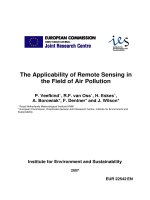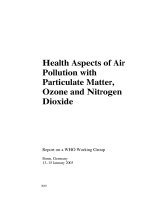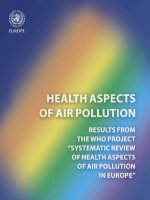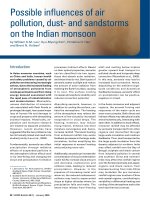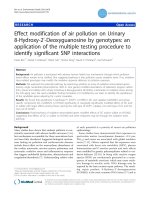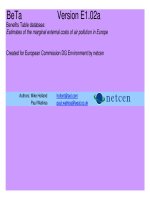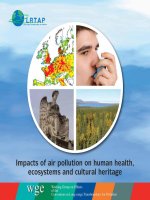FUNDAMENTALS Of AIR POLLUTION ENGINEERING potx
Bạn đang xem bản rút gọn của tài liệu. Xem và tải ngay bản đầy đủ của tài liệu tại đây (19.44 MB, 554 trang )
fUNDAMENTALS
Of
AIR
POLLUTION
ENGINEERING
fUNDAMENTALS
Of
AIR
POLLUTION
ENGINEERING
Richard C.
Flagan
John
H.
Seinfeld
California
Institute
of
Technology
PRENTICE HALL
Englewood Cliffs, New Jersey 07632
Library
of
Congress Cataloging-in-Publication Data
Flagan, Richard C. (date)
Fundamentals
of
air pollution engineering.
Includes bibliographies and index.
\.
Air-Pollution.
2. Environmental engineering.
1.
Seinfeld, John H. II. Title.
TD883.F38 1988 628.5'3 87-7322
ISBN 0-13-332537-7
Editorial/production supervision and
interior design: WordCrafters Editorial Services, Inc.
Cover design: Ben Santora
Manufacturing buyer: Cindy Grant
© 1988
by
Prentice-Hall, Inc.
A Division
of
Simon & Schuster
Englewood Cliffs, New Jersey 07632
All rights reserved. No part
of
this book may be
reproduced, in any form
or
by
any means,
without permission in writing from the publisher.
Printed in the United States
of
America
10
9 8 7 6 5 4 3 2 1
0-13-332537-7
Prentice-Hall International (UK) Limited, London
Prentice-Hall
of
Australia Pty. Limited, Sydney
Prentice-Hall Canada Inc., Toronto
Prentice-Hall Hispanoamericana, S.A., Mexico
Prentice-Hall
of
India Private Limited, New Delhi
Prentice-Hall
of
Japan, Inc., Tokyo
Simon
& Schuster Asia Pte. Ltd., Singapore
Editora Prentice-Hall do Brasil, Ltda., Rio de Janeiro
Contents
Preface
xi
Chapter
7
AIR
POLLUTION
ENGINEERING
1.1
Air
Pollutants
1.1.1 Oxides
of
Nitrogen
1.1.2
Sulfur Oxides
1.
1.3 Organic Compounds
1.1.4
Particulate Matter
1.2
Air
Pollution Legislation in the United States
1.3 Atmospheric Concentration Units
1.4
The
Appendices to this
Chapter
A Chemical Kinetics
A.1 Reaction Rates
A.2
The
Pseudo-Steady-State Approximation
A.3
Hydrocarbon Pyrolysis Kinetics
B Mass
and
Heat
Transfer
B.1 Basic Equations
of
Convective Diffusion
B.2 Steady-State Mass Transfer to
or
from a
Sphere in an Infinite Fluid
B.3
Heat
Transfer
B.4
Characteristic Times
C Elements
of
Probability Theory
C.1
The
Concept
of
a
Random
Variable
C.2
Properties
of
Random
Variables
C.3
Common
Probability Distributions
1
2
2
3
3
8
11
15
17
17
22
24
26
29
30
31
33
35
36
36
39
42
v
vi
Chapter
2
Chapter
3
D Turbulent Mixing
D. 1 Scales
of
Turbulence
D.2 Statistical Properties
of
Turbulence
D.3 The Microscale
D.4 Chemical Reactions
E Units
Problems
References
COMBUSTION
FUNDAMENTALS
2.1 Fuels
2.2 Combustion Stoichiometry
2.3 Combustion Thermodynamics
2.3.1 First Law
of
Thermodynamics
2.3.2
Adiabatic Flame Temperature
2.3.3
Chemical Equilibrium
2.3.4
Combustion Equilibria
2.4
Combustion Kinetics
2.4.1 Detailed Combustion Kinetics
2.4.2
Simplified Combustion Kinetics
2.5 Flame Propagation and Structure
2.5.1 Laminar Premixed Flames
2.5.2
Turbulent Premixed Flames
2.5.3
Laminar Diffusion Flames
2.5.4
Turbulent Diffusion Flames
2.6 Turbulent Mixing
2.7 Combustion
of
Liquid Fuels
2.8 Combustion
of
Solid Fuels
2.8. 1 Devolatilization
2.8.2
Char Oxidation
Problems
References
POLLUT
ANT
FORMATION
AND
CONTROL
IN
COMBUSTION
Contents
46
47
48
49
51
54
56
57
59
59
63
67
68
78
80
98
101
101
108
113
116
120
126
127
133
135
145
146
149
159
163
167
3.1 Nitrogen Oxides
167
3.1.1 Thermal Fixation
of
Atmospheric Nitrogen
168
3.1.2 Prompt NO 174
3.1.3 Thermal-NO
x
Formation and Control in
Combustors 176
3.1.4
Fue1-NO
x
180
3.1.5 Fuel-NO
x
Control
191
Contents
Chapter
4
3.1.6 Postcombustion Destruction
of
NO
x
3.1.7 Nitrogen Dioxide
3.2 Carbon Monoxide
3.2.1 Carbon Monoxide Oxidation Quenching
3.3 Hydrocarbons
3.4 Sulfur Oxides
Problems
References
INTERNAL
COMBUSTION
ENGINES
vii
191
198
201
204
215
217
221
222
226
4.1 Spark Ignition Engines 227
4.1.1 Engine Cycle Operation 229
4.1.2 Cycle Analysis
231
4.1.3 Cylinder Turbulence and Combustion Rate 234
4.1.4 Cylinder Pressure and Temperature 238
4.1.5 Formation
of
Nitrogen Oxides 240
4.1.6 Carbon Monoxide 242
4.1.7 Unburned Hydrocarbons 244
4.1.8 Combustion-Based Emission Controls 248
4.1.9 Mixture Preparation 254
4.1.10 Intake and Exhaust Processes 259
4.
1.
11
Crankcase Emissions
261
4.1.12 Evaporative Emissions
261
4. 1.13 Exhaust Gas Treatment 265
4.2 Diesel Engine 269
4.2.1 Diesel Engine Emissions and Emission
Control 272
4.2.2 Exhaust Gas Treatment 276
4.3 Stratified Charge Engines 277
4.4 Gas Turbines 280
Problems 286
References 287
Chapter
5
AEROSOLS
290
5.1 The Drag on a Single Particle: Stokes' Law
291
5.2 Noncontinuum Effects 293
5.2.1 The Knudsen Number 293
5.2.2 Slip Correction Factor 295
5.3 Motion
of
an Aerosol Particle in an External Force
Field 297
5.3.1 Terminal Settling Velocity 299
5.3.2 The Stokes Number 304
viii
Contents
5.3.3
Motion
of
a Charged Particle in an Electric
Field 305
5.3.4
Motion
of
a Particle Using the Drag
Coefficient 305
5.3.5 Aerodynamic Diameter 307
5.4
Brownian Motion
of
Aerosol Particles
308
5.4.1 Mobility and Drift Velocity
311
5.4.2
Solution
of
Diffusion Problems for Aerosol
Particles
312
5.4.3 Phoretic Effects
313
5.5 Diffusion to Single Particles
315
5.5.1 Continuum Regime
315
5.5.2
Free Molecule Regime
316
5.5.3
Transition Regime
316
5.6 The Size Distribution Function
321
5.6.1 Distributions Based on log D
p
322
5.6.2 Relating Size Distributions Based on
Different Independent Variables
323
5.7 The Log-Normal Distribution
325
5.8 General Dynamic Equation for Aerosols
328
5.8.1 Discrete General Dynamic Equation
328
5.8.2
Continuous General Dynamic Equation
329
5.9 Coagulation Coefficient
331
5.9.1 Brownian Coagulation
332
5.9.2 Effect of van der Waals and Viscous Forces
on Brownian Coagulation
333
5.10 Homogeneous Nucleation
340
5.
11
Sectional Representation
of
Aerosol Processes
347
Problems
349
References
356
Chapter
6
PARTICLE
FORMATION
IN
COMBUSTION
358
6.1 Ash
358
6.1.1
Ash Formation from Coal
359
6.1.2
Residual Ash Size Distribution
362
6.1.3
Ash Vaporization
364
6.1.4
Dynamics
of
the Submicron Ash Aerosol
370
6.2 Char and Coke
372
6.3 Soot
373
6.3.1
Soot Formation
375
6.3.2
Soot Oxidation
379
6.3.3
Control
of
Soot Formation
381
6.4 Motor Vehicle Exhaust Aerosols
385
Contents
ix
Problems
387
References
388
Chapter
7
REMOVAL
OF
PARTICLES
FROM
GAS
STREAMS
391
7.1
Collection Efficiency
393
7.2 Settling Chambers
394
7.2.1 Laminar Flow Settling Chamber
396
7.2.2 Plug Flow Settling Chamber
398
7.2.3 Turbulent Flow Settling Chamber
399
7.3
Cyclone Separators
402
7.3.1
Laminar Flow Cyclone Separators
404
7.3.2
Turbulent Flow Cyclone Separators
406
7.3.3 Cyclone Dimensions
408
7.3.4 Practical Equation for Cyclone Efficiency
408
7.4 Electrostatic Precipitation
411
7.4.1
Overall Design Equation for the Electrostatic
Precipitator
413
7.4.2
Generation
of
the Corona
415
7.4.3 Particle Charging
417
7.4.4 Field Charging
418
7.4.5
Diffusion Charging
420
7.4.6 The Electric Field
425
7.5
Filtration
of
Particles from Gas Streams
433
7.5.1
Collection Efficiency
of
a Fibrous Filter Bed
433
7.5.2
Mechanics
of
Collection by a Single Fiber
435
7.5.3 Flow Field around a Cylinder
436
7.5.4
Deposition
of
Particles on a Cylindrical
Collector by Brownian Diffusion
438
7.5.5
Deposition
of
Particles on a Cylindrical
Collector by Interception
440
7.5.6
Deposition
of
Particles on a Cylindrical
Collector by Inertial Impaction and
Interception
441
7.5.7 Collection Efficiency
of
a Cylindrical
Collector
449
7.5.8
Industrial Fabric Filters
452
7.5.9 Filtration
of
Particles by Granular Beds
455
7.6 Wet Collectors
456
7.6.1
Spray Chamber
459
7.6.2
Deposition
of
Particles on a Spherical
Collector
463
7.6.3
Venturi Scrubbers
467
x
Contents
7.7
Summary
of
Particulate Emission Control
Techniques
469
Problems
472
References
476
Chapter
8
REMOV
AL
OF
GASEOUS
POLLUTANTS
FROM
EFFLUENT STREAMS
479
8.1
Interfacial Mass Transfer
480
8.2
Absorption
of
Gases by Liquids
484
8.2.1
Gas Absorption without Chemical Reaction
484
8.2.2
Gas Absorption with Chemical Reaction
491
8.3
Adsorption
of
Gases on Solids
497
8.4 Removal
of
S02 from Effluent Streams
505
8.4.1 Throwaway Processes: Lime and Limestone
Scrubbing
506
8.4.2 Regenerative Processes
511
8.5
Removal
of
NO
x
from Effluent Streams
512
8.5.1 Shell Flue Gas Treating System
513
8.5.2 Wet Simultaneous
NO)SOx
Processes
513
8.5.3 Selective Noncatalytic Reduction
514
8.5.4 Selective Catalytic Reduction
515
8.5.5
NO
x
and SOx Removal by Electron Beam
516
Problems
517
References
519
Chapter
9
OPTIMAL
AIR
POLLUTION
CONTROL STRATEGIES
521
9.1
Long-Term Air Pollution Control
524
9.2
A Simple Example
of
Determining a Least-Cost Air
Pollution Control Strategy
526
9.3
General Statement
of
the Least-Cost Air Pollution
Control Problem
527
9.4 A Least-Cost Control Problem for Total Emissions
529
Problems
534
References
534
Index
537
Preface
Analysis and abatement
of
air pollution involve a variety
of
technical disciplines. For-
mation
of
the most prevalent pollutants occurs during the combustion process, a tightly
coupled system involving fluid flow, mass and energy transport, and chemical kinetics.
Its complexity is exemplified by the fact that, in many respects, the simplest hydrocarbon
combustion, the methane-oxygen flame, has been quantitatively modeled only within
the last several years. Nonetheless, the development
of
combustion modifications aimed
at minimizing the formation
of
the unwanted by-products
of
burning fuels requires an
understanding
of
the combustion process. Fuel may be available in solid, liquid, or
gaseous form; it may be mixed with the air ahead
of
time or only within the combustion
chamber; the chamber itself may vary from the piston and cylinder arrangement in an
automobile engine to a lO-story-high boiler in the largest power plant; the unwanted by-
products may remain as gases, or they may, upon cooling, form small particles.
The only effective way to control air pollution
is
to prevent the release
of
pollutants
at the source. Where pollutants are generated in combustion, modifications
to
the com-
bustion process itself, for example in the manner in which the fuel and air are mixed,
can be quite effective in reducing their formation. Most situations, whether a combustion
or an industrial process, however, require some degree
of
treatment
of
the exhaust gases
before they are released
to
the atmosphere. Such treatment can involve intimately con-
tacting the effluent gases with liquids or solids capable
of
selectively removing gaseous
pollutants or, in the case
of
particulate pollutants, directing the effluent
flow
through a
device in which the particles are captured on surfaces.
The study
of
the generation and control
of
air pollutants can be termed airpollution
engineering and
is
the subject
of
this book. Our goal here
is
to present a rigorous and
fundamental analysis
of
the production
of
air pollutants and their control. The book
is
xi
xii Preface
intended for use at the senior
or
first-year graduate level in chemical, civil, environ-
mental, and mechanical engineering curricula. We assume that the student has had basic
first courses in thermodynamics, fluid mechanics, and heat transfer. The material treated
in the book can serve
as
the subject
of
either a full-year or a one-term course, depending
on the choice
of
topics covered.
In the first chapter we introduce the concept
of
air pollution engineering and sum-
marize those species classified
as
air pollutants. Chapter 1 also contains four appendices
that present certain basic material that will be called upon later in the book. This material
includes chemical kinetics, the basic equations
of
heat and mass transfer, and some
elementary ideas from probability and turbulence.
Chapter 2 is'a basic treatment
of
combustion, including its chemistry and the role
of
mixing processes and flame structure. Building on the foundation laid in Chapter
2,
we present in Chapter 3 a comprehensive analysis
of
the formation
of
gaseous pollutants
in combustion. Continuing in this vein, Chapter 4 contains a thorough treatment
of
the
internal combustion engine, including its principles of operation and the mechanisms
of
formation
of
pollutants therein. Control methods based on combustion modification are
discussed in both Chapters 3 and 4.
Particulate matter (aerosols) constitutes the second major category
of
air pollutants
when classified on the basis
of
physical state. Chapter 5 is devoted to an introduction to
aerosols and principles
of
aerosol behavior, including the mechanics
of
particles in flow-
ing fluids, the migration
of
particles in external force fields, Brownian motion
of
small
particles, size distributions, coagulation, and formation
of
new particles from the vapor
by
homogeneous nucleation. Chapter 6 then treats the formation
of
particles in combus-
tion processes.
Chapters 7 and 8 present the basic theories
of
the removal
of
particulate and gas-
eous pollutants, respectively, from
effluent streams. We cover all the major air pollution
control operations, such
as
gravitational and centrifugal deposition, electrostatic precip-
itation, filtration, wet scrubbing, gas absorption and adsorption, and chemical reaction
methods. Our goal in these two chapters, above all, is to carefully derive the basic
equations governing the design
of
the control methods. Limited attention
is
given to
actual equipment specification, although with the material in Chapters 7 and 8 serving
as a basis, one will be able to proceed to design handbooks for such specifications.
Chapters 2 through 8 treat air pollution engineering from a process-by-process
point
of
view. Chapter 9 views the air pollution control problem for an entire region or
airshed. To comply with national ambient air quality standards that prescribe, on the
basis
of
health effects, the maximum atmospheric concentration level
to
be attained in a
region, it
is
necessary for the relevant governmental authority to specify the degree
to
which the emissions from each
of
the sources
in
the region must be controlled. Thus it
is
generally necessary
to
choose among many alternatives that may lead to the same total
quantity
of
emission over the region. Chapter 9 establishes a framework
by
which an
optimal air pollution control plan for an airshed may be determined. In short, we seek
the least-cost combination
of
abatement measures that meets the necessary constraint
that the total emissions not exceed those required
to
meet an ambient air quality standard.
Once pollutants are released into the atmosphere, they are acted on
by
a variety
of
Preface xiii
chemical and physical phenomena. The atmospheric chemistry and physics
of
air pol-
lution
is
indeed a rich arena, encompassing the disciplines
of
chemistry, meteorology,
fluid mechanics, and aerosol science. As noted above, the subject matter
of
the present
book ends at the stack (or the tailpipe); those readers desiring a treatment
of
the atmo-
spheric behavior
of
air pollutants are referred to J. H. Seinfeld, Atmospheric Chemistry
and Physics
of
Air
Pollution (Wiley-Interscience, New York, 1986).
We wish to gratefully acknowledge David Huang, Carol Jones, Sonya Kreiden-
weis, Ranajit Sahu, and Ken Wolfenbarger for their assistance with calculations in the
book.
Finally, to Christina Conti, our secretary and copy editor, who, more than anyone
else, kept safe the beauty and precision
of
language as an effective means
of
commu-
nication, we owe an enormous debt
of
gratitude. She nurtured this book as her own;
through those times when the task seemed unending, she was always there to make the
road a little smoother.
R. C. Flagan
J. H. Seinfeld
FUNDAMENTALS
OF
AIR
POLLUTION
ENGINEERING
1
Air
Pollution
Engineering
The phenomenon
of
air pollution involves a sequence
of
events: the generation
of
pol-
lutants at and their release from a source; their transport and transfonnation in and re-
moval from the atmosphere; and their effects on human beings, materials, and ecosys-
tems. Because it is generally either economically infeasible or technically impossible to
design processes for absolutely zero emissions
of
air pollutants, we seek to control the
emissions to a level such that effects are either nonexistent or minimized.
We can divide the study
of
air pollution into three obviously overlapping but some-
what distinct areas:
1. The generation and control
of
air pollutants at their source. This first area involves
everything that occurs before the pollutant is released
"up
the stack" or
"out
the
tailpipe. "
2. The transport, dispersion, chemical transfonnation in, and removal
of
species from
the atmosphere. This second area thus includes all the chemical and physical pro-
cesses that take place between the point
of
emission and ultimate removal from
the atmosphere.
3. The effects
of
air pollutants on human beings, animals, materials, vegetation, crops,
and forest and aquatic ecosystems, including the measurement
of
gaseous and par-
ticulate species.
An air pollution control strategy for a region is a specification
of
the allowable
levels
of
pollutant emissions from sources. To fonnulate such a strategy it is necessary
to be able to estimate the atmospheric fate
of
the emissions, and thus the ambient con-
centrations,
so
that these concentrations can
be
compared with those considered to give
2
Air
Pollution
Engineering
Chap.
1
rise to adverse effects. The ultimate mix
of
control actions and devices employed to
achieve the allowable levels might then be decided on an economic basis. Therefore,
the formulation
of
an air pollution control strategy for a region involves a critical feed-
back from area 3 to area
1.
Consequently, all three of the areas above are important in
air pollution abatement planning.
A comprehensive treatment
of
each
of
these three areas
is
beyond the scope
of
a
single book, however. The present book is devoted to an in-depth analysis
of
the gen-
eration and control
of
air pollutants at their source, which we refer to as air pollution
engineering.
1.1 AIR POLLUTANTS
Table 1.1 summarizes species classified as air pollutants.
By
and large our focus in this
book
is
on the major combustion-generated compounds, such as the oxides
of
nitrogen,
sulfur dioxide, carbon monoxide, unburned hydrocarbons, and particulate matter. Table
1.2 provides a list
of
the most prevalent hydrocarbons identified in ambient air, and
Table 1.3 lists potentially toxic atmospheric organic species.
1.1.1
Oxides of Nitrogen
Nitric oxide (NO) and nitrogen dioxide
(N0
2
)
are the two most important nitrogen oxide
air pollutants. They are frequently lumped together under the designation NO
x
,
although
analytical techniques can distinguish clearly between them.
Of
the two,
N0
2
is
the more
toxic and irritating compound.
Nitric oxide
is
a principal by-product
of
combustion processes, arising from the
high-temperature reaction between N
2
and O
2
in the combustion air and from the oxi-
dation
of
organically bound nitrogen in certain fuels such as coal and oil. The oxidation
of
N
2
by the O
2
in combustion air occurs primarily through the two reactions
N
2
+ °
NO
+ N
N
+ O
2
NO + °
known as the Zeldovich mechanism. The first reaction above has a relatively high acti-
vation energy, due
to
the need to break the strong N
2
bond. Because
of
the high acti-
vation energy, the first reaction
is
the rate-limiting step for NO production, proceeds at
a somewhat slower rate than the combustion
of
the fuel, and
is
highly temperature sen-
sitive. Nitric oxide formed via this route is referred to as thermal-NOr The second major
mechanism for NO formation in combustion
is
by the oxidation
of
organically bound
nitrogen in the fuel. For example, number 6 residual fuel oil contains 0.2 to 0.8% by
weight bound nitrogen, and coal typically contains 1
to
2
%,
a portion
of
which
is
con-
verted to NO
x
during combustion. (The remainder
is
generally converted to N
2
.)
Nitric
oxide formed in this manner
is
referred to as fuel-NOr
Mobile combustion and fossil-fuel power generation are the two largest anthro-
Sec.
1.1
Air
Pollutants
3
pogenic sources
of
NOr
In addition, industrial processes and agricultural operations
produce minor quantities. Emissions are generally reported as though the compound
being emitted were
N0
2
. This method
of
presentation serves the purpose
of
allowing
ready comparison
of
different sources and avoids the difficulty in interpretation associ-
ated with different ratios
of
NO
/N0
2
being emitted by different sources. Table 1.4 gives
NO
/NO
x
ratios
of
various types
of
sources. We see that, although NO
is
the dominant
NO
x
compound emitted by most sources,
N0
2
fractions from sources do vary somewhat
with source type. Once emitted, NO can be oxidized quite effectively to
N0
2
in the
atmosphere through atmospheric reactions, although we will not treat these reactions
here. Table 1.5 gives estimated U.S. emissions
of
NO
x
in 1976 according to source
category. Utility boilers represent about
50%
of
all stationary source NO
x
emissions in
the United States. As a result, utility boilers have received the greatest attention in past
NO
x
regulatory strategies and are expected to be emphasized in future plans
to
attain
and maintain
NO
x
ambient air quality standards.
1.1.2
Sulfur Oxides
Sulfur dioxide (S02)
is
formed from the oxidation
of
sulfur contained in fuel as well as
from certain industrial processes that utilize sulfur-containing compounds. Anthropo-
genic emissions
of
S02 result almost exclusively from stationary point sources. Esti-
mated annual emissions
of
S02 in the United States in 1978 are given in Table 1.6. A
small fraction
of
sulfur oxides
is
emitted as primary sulfates, gaseous sulfur trioxide
(S03), and sulfuric acid (H
2
S0
4
),
It
is estimated that, by volume, over 90%
of
the total
U.S. sulfur oxide emissions are in the form
of
S02, with primary sulfates accounting for
the other
10
%.
Stationary fuel combustion (primarily utility and industrial) and industrial pro-
cesses (primarily smelting) are the main S02 sources. Stationary fuel combustion in-
cludes all boilers, heaters, and furnaces found in utilities, industry, and commercial!
institutional and residential establishments. Coal combustion has traditionally been the
largest stationary fuel combustion source, although industrial and residential coal use
has declined. Increased coal use by electric utilities, however, has offset this decrease.
S02 emissions from electric utilities account for more than half
of
the U.
S.
total. A more
detailed breakdown
of
U.S. sulfur oxide emissions in 1978
is
given in Table 1.7.
1.1.3
Organic Compounds
Tables 1.2 and 1.3 list a number
of
airborne organic compounds. Organic air pollutants
are sometimes divided according to volatile organic compounds (VOCs) and particulate
organic compounds (POCs), although there are some species that will actually be dis-
tributed between the gaseous and particulate phases. The emission
of
unburned
or
par-
tially burned fuel from combustion processes and escape
of
organic vapors from indus-
trial operations are the major anthropogenic sources
of
organic air pollutants.
A major source
of
airborne organic compounds
is
the emissions from motor ve-
TABLE 1.1
AIR POLLUTANTS
Physical properties Concentration levels" Anthropogenic sources
Natural sources
S02 Colorless gas with irritating, Global background concentration
Fuel combustion in Atmospheric oxidation
of
pungent odor; detectable levels in the range 0.04 to 6 ppb; stationary sources;
organic sulfides
by taste at levels
of
0.3 to
hourly averaged maximum
industrial process
I ppm; highly soluble in concentrations in urban areas emissions; metal and
water (10.5
g/lOO
cm'
at
have occasionally exceeded I
petroleum refining
293
K)
ppm
H
2
S
Colorless, flammable gas; Global background about 3
p.g
Kraft pulp mills; natural gas
Biological decay processes;
highly toxic;
m-';
urban levels have been and petroleum refining;
volcanoes and geothermal
characteristic rotten egg
observed as large as 390
p.g
m
-,
rayon and nylon
activities
odor manufacture; coke ovens
NO
Colorless, odorless gas;
Global background level from 10 to
Combustion
Bacterial action; natural
nonflammable and slightly
100 ppt; urban levels have been
combustion processes;
soluble in water; toxic
observed as large as 500 ppb
lightning
N0
2
Reddish-orange-brown gas
Global background level from
10
to
Combustion
with sharp, pungent odor;
500 ppt; urban concentrations
toxic and highly have reached values exceeding
corrosive; absorbs light 500 ppb
over much
of
the visible
spectrum
NH,
Colorless gas with pungent Global background level
of
I ppb; Combustion
Bacterial decomposition
of
odor; detectable at urban concentrations in range
of
amino acids in organic
concentrations exceeding 5 ppb
waste
500 ppm; highly soluble
in water
CO
2
Colorless, odorless, Global background concentration Combustion of fossil fuels
nontoxic gas moderately has increased from 290 ppm in
soluble in water
1900 to about 345 ppm in 1985
co
Nonmethane
hydrocarbons
(see Table
1.2)
Colorless, odorless,
flammable, toxic gas,
slightly soluble in water
Colorless, toxic gas, slightly
soluble in water
Global average concentration
of
0.09 ppm; concentrations in
northern hemisphere are about
twice those in southern
hemisphere; urban levels in the
vicinity
of
heavily traveled
roadways can exceed 100 ppm
Global background concentrations
range from 20 to 60 ppb;
polluted urban levels range from
100 to 500 ppb
Global background concentrations
range from
10
to 20 ppb;
polluted urban levels range from
500
to
1200 ppb
Combustion
of
fossil fuels
No primary sources; formed
as a secondary pollutant
from atmospheric
reactions involving
hydrocarbons and oxides
of
nitrogen
Incomplete combustion;
industrial sources
Atmospheric oxidation
of
methane and other
biogenic hydrocarbons
Natural tropospheric
chemistry; transport from
stratosphere to
troposphere
Vegetation
"Two concentration units that are commonly used in reporting atmospheric species abundances are
p.g
m-
3
and parts per million
by
volume (ppm). Parts per million
by
volume is not really a concentration but a dimensionless volume fraction, although it is widely referred to
as
a "concentration." Parts per million by volume
may be expressed as
"concentration"
of
species i in ppm = S X
10
6
C
where
c,
and c are moles/volume
of
species i and air, respectively, atp and
T.
Given a pollutant mass concentration
m,
expressed in
p.g
m-
3
10-
6
m,
c,=~
where M, is the molecular weight
of
species i and c = p / RT. Thus the "concentration"
of
a species in ppm is related to that in
p.g
m
-3
by
RT
"concentration"
of
species i in ppm = - X concentration in
p.g
m-
3
pM,
Parts per billion
by
volume (ppb) is just
(c,/c)
X
10
9
.
6
Air
Pollution Engineering
Chap.
1
TABLE
1.2
HYDROCARBONS IDENTIFIED
IN
AMBIENT AIR
Carbon
number
2
3
4
5
6
Compound
Methane
Ethane
Ethylene
Acetylene
Propane
Propylene
Propadiene
Methylacetylene
Butane
Isobutane
I-Butene
cis-2-Butene
trans-2-Butene
Isobutene
1,3-Butadiene
Pentane
Isopentane
I-Pentene
cis-2-Pentene
trans-2-Pentene
2-Methyl-I-butene
2-Methyl-I,3-butadiene
Cyclopentane
Cyclopentene
Isoprene
Hexane
2-Methylpentane
3-MethyIpentane
2,2-
DimethyIbutane
Carbon
number
7
8
9
10
Compound
2,3-
DimethyIbutane
cis-2-Hexene
trans-2-Hexene
cis-3-Hexene
trans-3-Hexene
2-Methyl-I-pentene
4-Methyl-I-pentene
4-Methyl-2-pentene
Benzene
Cyclohexane
Methylcyclopentane
2-MethyIhexane
3-Methylhexane
2,3-Dimethylpentane
2,4-DimethyIpentane
Toluene
2,2,4-
Trimethylpentane
Ethylbenzene
a-Xylene
m-Xylene
p-Xylene
m-Ethy!toluene
p-Ethyltoluene
1,2,4-Trimethylbenzene
1,3,5-Trimethylbenzene
sec-Butylbenzene
a-Pinene
~-Pinene
3-Carene
Limonene
hicles. Motor vehicle emissions consist
of
unburned fuel, * in the form
of
organic com-
pounds; oxides
of
nitrogen, in the form primarily
of
nitric oxide; carbon monoxide; and
particulate matter. Since motor vehicle emissions vary with driving mode (idle, accel-
erate, decelerate, cruise), to obtain a single representative emission figure for a vehicle,
it
is
run through a so-called driving cycle in which different driving modes are attained
*Gasoline is the 313 to 537 K fraction from petroleum distillation and contains approximately 2000
compounds. These include
C.
to C
9
paraffins, olefins, and aromatics. Typical compositions vary from 4%
olefins and 48% aromatics to 22% olefins and 20% aromatics. Unleaded fuel has a higher aromatic content
than leaded fuel.
Sec.
1.1
Air
Pollutants
7
TABLE 1.3 POTENTIALLY
HAZARDOUS
AIR
POLLUTANTS
Chemical name
Halomethanes
Methyl chloride
Methyl bromide
Methyl iodide
Methylene chloride
Chloroform
Carbon
tetrachloride
Haloethanes and halopropanes
EthyI chloride
1,2-Dichloroethane
1,2-Dibromoethane
i ,1,I-Trichloroethane
1,1,2-
Trichloroethane
1,1,2,2-
Tetrachloroethane
1,2-Dichloropropane
Chloroalkenes
Vinylidene chloride
Trichloroethylene
Tetrachloroethylene
AllyI chloride
Hexachloro-I,3-butadiene
Chloroaromatics
Monochlorobenzene
a-Chlorotoluene
0-
Dichlorobenzene
m-Dichlorobenzene
1,2,4-
Trichlorobenzene
Aromatic hydrocarbon
Benzene
Oxygenated and nitrogenated species
Formaldehyde
Phosgene
PeroxyacetyI nitrate (PAN)
Peroxypropionyl nitrate (PPN)
Acrylonitrile
Chemical formula
CH
3
C1
CH
3
Br
CH
3
1
CH
2
CI
2
CHCI
3
CCI.
C
2
H
3
C1
CH
2
C1CH
2
C1
CH
2
BrCH
2
Br
CH
3
CCl
3
CH
2
CICHCI
2
CHCI
2
CHCI
2
CH
2
CICHCICH
3
CH
2
=CCl,
CHCI=CCl
2
CCI
2
=CCI
2
CICH
2
CH=CH
2
CI
2
C=CCI-CCI
=CCl
2
C
6
H
s
CI
CoHsCH
2
C1
o-C
6
H.Cl
2
m-C
6
H.CI
2
1,2,4-C
6
H
3
CI
3
HCHO
COCl
2
CH
3
COOON0
2
CH
3
CH
2
COOON0
2
CH""CN
Toxicity"
BM
BM
SC,
BM
BM
SC,
BM
SC, NBM
SC,
BM
SC
WeakBM
SC,NBM
SC,
BM
BM
SC,
BM
SC,BM
SC
SC
BM
BM
SC
SC,
BM
Phytotoxic
Phytotoxic
SC
Average
concentration
b
(ppt)
788
141
2.7
978
346
221
100
558
32
512
29
10
60
19
143
401
<5
5
280
<5
12
6
5
3,883
14,200
<20
589
103
"BM;
positive mutagenic activity based
on
Ames
salmonella mutagenicity test (bacterial mutagens);
NBM,
not found to be mutagenic in the Ames salmonella test (not bacterial mutagens); SC, suspected carcino-
gens.
b Average from 2 weeks
of
measurements in
Houston,
St. Louis, Denver, and Riverside.
Source: Singh et al. (1981).
8
Air
Pollution
Engineering
TABLE
1.4
NO/NO
x
RATIOS
IN
EMISSIONS FROM
VARIOUS SOURCE TYPES
Chap.
1
Source type
Industrial boilers
Natural gas
Coal
No.6
fuel oil
Motor vehicle
Internal combustion engine
Diesel-powered car
Diesel-powered truck and bus
Uncontrolled tail gas from nitric acid plant
Petroleum refinery heater: natural gas
Gas turbine electrical generator:
No.2
fuel oil
NO/NO
x
0.90-1.0
0.95-1.0
0.96-1.0
0.99-1.0
0.77-1.0"
0.73-0.98
-0.50
0.93-1.0
0.55-1.0
b
"The lower limit
is
for idle conditions; the higher for 50
mi/hr
(80.5
km
h-
1
).
hThe lower limit is for no load; the higher for full load.
Source: U.S. Environmental Protection Agency (l982a).
for prescribed periods.
The
driving cycle
is
carried out in the laboratory on a device
called a dynamometer that offers the same resistance to the engine
as
actual road driving.
Three different driving cycles have been employed in emissions testing: the Fed-
eral Test Procedure (FTP), a cycle reflecting a mix
of
low and high speeds; the New
York City Cycle (NYCC), a low-speed cycle to represent city driving; and the Crowded
Urban Expressway (CUE) cycle, representative
of
high-speed driving. The average cycle
speeds
of
the three cycles are:
FTP-19.56
mi/hr
(31.5 kIn
h-
1
);
NYCC-7.07
mi/hr
(11.4 kIn
h-
1
);
CUE-34.79
mi/hr
(56.0 kIn
h-
1
).
Emissions
of
all pollutants are
generally larger for the lower-speed cycles.
1
.1.4
Particulate
Matter
Particulate matter refers
to
everything emitted in the form
of
a condensed (liquid or solid)
phase. Table 1.7 gives the total estimated U.S. particulate matter emissions in 1978,
and Table 1.8 presents a summary
of
the chemical characteristics
of
uncontrolled par-
ticulate emissions from typical air pollution sources.
In
utili~y
and industrial use, coal and, to a lesser extent, oil combustion contribute
most
of
the particulate (and sulfur oxides) emissions. Coal is a slow-burning fuel with
a relatively high ash (incombustible inorganic) content. Coal combustion particles con-
sist primarily
of
carbon, silica
(Si0
2
),
alumina
(AI
2
0
3
),
and iron oxide (FeO and
Fe
z
0
3
).
In contrast to coal, oil is a fast-burning, low-ash fuel. The low ash content results in
formation
of
less particulate matter, but the sizes
of
particles formed in oil combustion
are generally smaller than those
of
particles from coal combustion. Oil combustion par-
ticulate matter contains cadmium, cobalt, copper, nickel, and vanadium.
Sec.
1.1
Air
Pollutants
TABLE
1.5
ESTIMATED ANTHROPOGENIC
NO
x
EMISSIONS
IN
THE UNITED STATES
IN
1976
(10
6
metric
tons
/ yr, expressed
as
N0
2
)a
Source category
9
Transportation
Highway vehicles
Nonhighway vehicles
Stationary fuel combustion
Electric utilities
Industrial
Residential, commercial, and institutional
Industrial processes
Chemicals
Petroleum refining
Metals
Mineral products
Oil and gas production and marketing
Industrial organic solvent use
Other processes
Solid waste disposal
Miscellaneous
Forest wildfires and managed burning
Agricultural burning
Coal refuse burning
Structural fires
Miscellaneous organic solvent use
10.1
7.8
2.3
11.8
6.6
4.5
0.7
0.7
0.3
0.3
o
0.1
Ob
o
o
0.1
0.3
0.2
o
0.1
o
_0_
23.0
a One metric ton = 10
3
kg.
b A zero entry indicates emissions
of
less than 50,000 metric
tons/yr.
Source: U.S. Environmental Protection Agency (l982a).
TABLE
1.6
ESTIMATED
ANTHROPOGENIC
S02
EMISSIONS
IN
THE UNITED STATES
IN
1978
(10
6
metric
tons/yr)
Source category
Stationary fuel combustion
Industrial processes
Transportation
Source:
U.
S. Environmental Protection
Agency (l982b).
22.1
4.1
~
27.0
10
Air
Pollution
Engineering
Chap.
1
TABLE
1.7
ESTIMATED ANTHROPOGENIC SULFUR OXIDE AND PARTICULATE
MATTER EMISSIONS FROM
STATIONARY
SOURCES
IN
THE UNITED STATES
IN
1978
(10
3
metric
tons/yr)
Source category
Sulfur oxides
Particulate
matter
Fuel combustion
Utility
Coal
Oil
Gas
Industrial
Coal
Oil
Gas
Other fuels"
Commercial/institutional
Coal
Oil
Gas
Residential
Coal
Oil
Gas
Industrial processes
Metals
Iron and steel
Primary smelting
Iron foundries
Other
Mineral products
Cement
Asphalt
Lime
Crushed rock
Other
Petroleum
Refining
Natural gas production
Chemical
Sulfuric acid
Other
Other
Grain processing
Pulp and paper
Other
Solid waste disposal
15,900
2,350
1,720
140
0
10
1,890
700
1,150
90
0
40
150
280
40
20
900
60
0
10
60
20
260
20
0
30
110
830
1,960
480
0
140
0
120
670 780
0
150
0
150
0
1,340
30
910
900
70
140
0
220
0
0
190
0
730
80
240
0
60
__
0
~
26,180
10,460
"Primarily wood/bark waste.
Source: U.S. Environmental Protection Agency (l982b).
Sec.
1.2
Air
Pollution
Legislation
in
the
United
States
11
Major industrial process sources
of
particulate matter include the metals, mineral
products, petroleum, and chemicals industries. Iron and steel and primary smelting op-
erations are the most significant emission sources in the metals industry. The iron and
steel industry involves coke, iron, and steel production, each
of
which
is
a source
of
particulate emissions. The primary metals industry includes the smelting
of
copper, lead,
and zinc, along with aluminum production. Sulfur in unprocessed ores
is
converted
to
S02 during smelting, with a relatively small portion emitted as particulate sulfate and
sulfuric acid. Emissions from the mineral products industry result from the production
of
portland cement, asphalt, crushed rock, lime, glass, gypsum, brick, fiberglass, phos-
phate rock, and potash. The particles emitted from crushing, screening, conveying,
grinding, and loading operations tend to be larger than
15
p.m.
1.2
AIR POLLUTION LEGISLATION
IN
THE UNITED STATES
The 1970 Clean Air Act Amendments* was a major piece
of
legislation that in many
respects first put teeth into air pollution control in the United States. A major goal
of
the Act was to achieve clean air by 1975. The Act required the Environmental Protection
Agency (EPA) to establish National Ambient Air Quality Standards
(NAAQS)-both
primary standards (to protect public health) and secondary standards (to protect public
welfare). The Act also required states to submit State Implementation Plans (SIPs) for
attaining and maintaining the national primary standards within three years.
Automobile emissions were arbitrarily set at a 90% reduction from the 1970 (for
CO and hydrocarbons)
or
1971
(for
NO
x
)
model year emissions to be achieved by 1975
(or
1976 for
NO
x
)'
Since there was no proven way to achieve these goals when the law
was enacted, the industry was in effect forced
to
develop new technology to meet the
standards by a certain deadline. This has been called "technology-forcing legislation."
Emissions standards were to be written
by
the EPA for certain new industrial plants.
These New Source Performance Standards (NSPS) represented national standards that
were to be implemented and enforced by each state.
The Clean Air Act Amendments
of
1977 incorporated a number
of
modifications
and additions to the 1970 Act, although it retained the basic philosophy
of
federal man-
agement with state implementation.
In
this Act, the EPA was required to review and
update, as necessary, air quality criteria and regulations as
of
January
1,
1980 and at
five-year intervals thereafter. A new aspect was included for "prevention
of
significant
deterioration" (PSD)
of
air quality in regions cleaner than the NAAQS. Prior to the
1977 Amendments it was theoretically possible to locate air pollution sources in such
regions and pollute clean air up to the limits
of
the ambient standards. However, the Act
defined class 1 (pristine) areas, class
2 (almost all other areas), and class 3 (industrial-
ized) areas. Under the PSD provisions, the ambient concentrations
of
pollutants will be
*The original Clean Air Act was passed in 1963.
TABLE
1.8
CHARACTERISTICS
OF
UNCONTROLLED PARTICULATE EMISSIONS
Particle size
(weight
% less than stated size)
Chemical composition
Source category
Fuel combustion
Utility
Coal
Oil
Industrial
Oil
Gas
Commercial/institutional/
residential
Oil
Gas
Industrial processes
Metals
Iron and steel
15-90
95
2.5
I'm
5-70
70-95
35-99
1-15
5-20
65-95
100
100
30-95
Major elements and compounds
AI, Ca, Fe, Si, sulfates, organics
AI, Ca, Fe, Mg, Na, sulfates, organics
AI, Fe, Mg, Si, sulfates, organics
CI, Na, sulfates, organics
AI, Ca, Mg, Zn, sulfates
CI, Na, sulfates, organics
AI, C, Ca, Cr, Fe, K, Mg, Mn, Pb,
Si, Zn, sulfates, organics
Trace elements
(less than I% by weight)
As, B, Ba, Be, Cd, Cl, Co, Cr, Cu, F,
Hg, K, Mg, Mn, Na, Ni, P, Pb, S,
Se, Ti,
V,
Zn,
Zr
As, Ba, Br, Co, Cr, Cu, K, Mn, Mo,
Ni, Pb, Se, Sr, Ti,
V
As, Ba, Ca, Cd, Co, Cr, Cu, Hg, K,
Mo, Ni, Pb, Se, Sr, Ti, V, Zn
As, Ba, Cd, Cr, Cu, Hg,
K, Ni, Pb,
Sb, C
Ag, As, Br, Cd, Cs, Cu, F, I, Mo, Ni,
Rb, Se, Sn, Sr, V,
Zr
